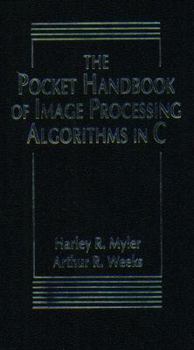The Pocket Handbook of Image Processing Algorithms in C
This handy desktop reference gathers together into one easy-to-use volume the most popular image processing algorithms. Designed to be used at the computer terminal, it features an illustrated,... This description may be from another edition of this product.
Format:Hardcover
Language:English
ISBN:0136422403
ISBN13:9780136422402
Release Date:January 1993
Publisher:Prentice Hall
Length:303 Pages
Weight:0.36 lbs.
Dimensions:0.7" x 3.3" x 5.8"
Related Subjects
C & C++ Windows Programming Computer Science Computer Technology Computers Computers & Technology Development Education & Reference Electrical & Electronic Engineering Electrical & Electronics Engineering Graphic Design Languages & Tools Physics Programming Programming Languages Science & Math TechnologyCustomer Reviews
5 ratings
Excellent cookbook of image processing algorithms
Published by Thriftbooks.com User , 19 years ago
This book is excellent if you use it as intended - to lift working C code for the implementation of a variety of image processing algorithms. There are even algorithms for computer vision techniques such as circularity, compactness, and finding the minimum or maximum axis. This book assumes that you already know how to program in C and that you are already familiar with the theory of image processing as it was never intended to be a textbook on either of these subjects. However, this does not mean that this cookbook is devoid of theory. Each transform contains a short description of its purpose, a before and after image showing its effect, a paragraph describing the algorithm, and then the C code that performs the transform. Some reviewers have complained about the C code, but to me it was commented well enough that I have been able to easily translate several of the algorithms into Java for an application I have been writing. Depending on the complexity of the transform there may also be a diagram or an equation included. The algorithms are laid out in alphabetical order, so as to be convenient for quick look-up. It is true that the code assumes in most cases that the input image is a 256 level gray scale image, but then if the reader is familiar with image processing it should be easy to extend any of these transforms to color images. Where this book is weakest and most shows its age is in the class of transformations labeled "storage formats". For the image types the user is still most likely to encounter- GIF, JPEG, and TIF- the book only shows routines that tell you how to determine if the file is or isn't one of these types. Details on decoding or encoding these image types is beyond the scope of the book. The book does include details for PC Paintbrush and MacPaint formats. However, these simple image storage formats are no longer commonly used. I don't think that this one weakness negates the usefulness of this book for the vast majority of readers.
Useful, full of stuff, but old and in some cases wrong...
Published by Thriftbooks.com User , 20 years ago
Plusses: lots of algorithms, good pseudo-code for implementing them, very easy to find stuff. Minuses: some of the code presented is outdated (MacPaint files? Really, now...), while others are inaccurate. The 'Thinning' code generates incorrect results; it finds critical points, but does not produce a connected skeleton.
Author's Comment
Published by Thriftbooks.com User , 21 years ago
Potential buyers, please keep in mind that this book is for people that already know image processing theory or are enrolled in a course. We wrote this book for the student engineer to rapidly be able to code algorithms. They are very simply written, more so for understanding and ease of typing (most are one small page) than for algorithmic elegance or efficiency. Note that the book is very small and has a soft leatherette cover--this is so it fits comfortably in your back pocket and can be pulled out as needed. There is no CD, type the code in yourself and learn as you go. Some things are done for a reason, enjoy!
It's easy to read.
Published by Thriftbooks.com User , 22 years ago
It intruduced broad terms of image processing tech. It's practical and easy to understand. It might only take you a couple of days to finish reading it.
Useful little book
Published by Thriftbooks.com User , 25 years ago
This book presents many algorithms and their C implementations in alphabetical order. Many of the entries show the result of the algorithm's application on an image. A table of contents groups the algorithms into classes, such as image fundamentals (convolution, correlation), morphological filters, and nonlinear filters. The basic stuff is all there. Also included in the appendix are programs to read and write image data, which can be used in conjunction with the C code listed for each algorithm for a working solution.The theory is not emphasized, so readers should look elsewhere for that information. However, considering its small size, this book offers a lot of very useful information.





